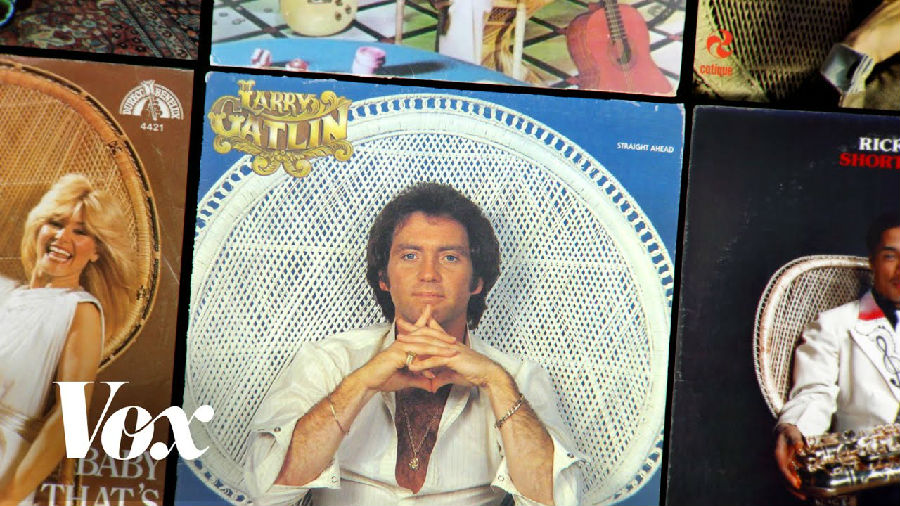This is Drake’s dad pictured on the cover of his 2017 album More Life.
这是德雷克(公鸭)2017年《More Life》的封面人物——他的父亲。
This is French comedian Jacques Bodoin in 1969.
这是1969年法国喜剧演员雅克·博登的照片。
This is country star Larry Gatlin in 1979 and soul artist Al Green in 1972.
这是1979年乡村歌手拉里·加特林的照片,1972年的灵魂乐泰斗阿尔·格林的照片。
This is the British synthpop band, Heaven 17, in 1981.
这是英国流行乐队Heaven 171981年的一张照片。
These artists' work span decades, genres, and continents, but their album art had one thing in common.
这些文艺工作者的作品不仅跨越了数十年的时间,也跨越了体裁和地域,但他们的照片都有一个共同点。
They were all sitting in the same exact chair.
他们坐的是同一款椅子。
And it wasn’t just them, this chair popped up on album covers everywhere.
而且,不仅仅是他们,各大封面上全都是这款椅子。
Now, you could easily chalk this up to being one of many weird album cover trends over the years.
大家很可能会将次归咎于多年来一波又一波奇奇怪怪的专辑封面造型趋势之一。
But in the 1970s, when these album covers were pretty much unavoidable,
然而,在70年代的时候,这种封面几乎是无可避免的,
they were actually following a photography trope that was 100 years in the making.
它们其实是在跟风当时已经酝酿了100年的一种拍摄手法。
Let’s start with this photograph of Charles Darwin, the famed naturalist, relaxing in his old age at his English home in 1880.
我们先从著名的自然科学家达尔文的这张照片开始说起。照片中,他正在他英国的家中安享晚年。
On this wicker chair.
正坐在这把藤椅上。
At the turn of the 20th century, wicker furniture was all the rage.
在20世纪初,柳条家具可谓风靡一时。
Its success was driven by the fact that breezy open air spaces, like verandas and porches, were in high demand.
它的成功源于凉风习习的开放空间,比如阳台和门廊,在当时十分火爆这一事实。
This was long before homes were air conditioned,
那时距离空调入户还有很长一段时间,
and when the summer came around, no one in their right mind - and with a decent amount of money - wanted to overheat.
夏天来临的时候,凡是头脑正常——加上口袋充实——的人,是不会想中暑的。
This June 1914 guide on “How to have a cool house” suggests replacing walls with curtains,
这本1914年6月刊的“如何打造一个凉爽的家”的指南就建议大家用帘子代替墙壁,
building sleeping porches, and filling the entire living space with wicker furniture.
打造一个睡廊并将家具一律换成藤编家具。
In short, “bring summer into the house.”
简而言之,“把夏天请到家里来。”
Outside of the home, wicker was used in resort hotels, at the beach and on ocean liners and passenger planes.
除了家里,度假酒店,海滩,远洋轮船,飞机上也用了藤条家具。

And it wasn’t just furniture, there were wicker baby carriages and wheelchairs and this….thing.
不止有家具,还有藤条婴儿车,藤条轮椅以及……这玩意儿。
But perhaps its most lasting function well, besides baskets was its use in portrait photography.
但除了编成篮子,藤条最持久的功能或许要数其在肖像摄影时发挥的作用。
Wicker was light and easy to move around, and it was breathable, great for when hot lights warmed the studio.
藤条很轻,移动方便,还很透气,非常适合被高温灯光照得很热的工作室使用。
More importantly it could be woven into countless eye-catching decorative forms.
更重要的是,它能被编成各种各样夺人眼球的装饰造型。
Many of these designs - particularly this ornate asymmetrical one - were actually called photographer’s chairs, or posing chairs.
这些设计当中,有许多——尤其是这种华丽的不对称的设计——都被称之为了“摄影师的椅子”,或“摆拍椅”。
From the late 1800s well into the 20th century, no portrait was complete without a trusty wicker chair.
从19世纪末到20世纪开始很久以后,没有一把可靠的藤椅的肖像照都算不上一张完整的肖像照。
Now these were everyday people - a young woman a mother and child. A handy man and shoe polisher.
这些都是普通人——年轻女子,母子,手艺人,擦鞋工。
But just as often you’d see portraits of powerful, influential people photographed in wicker chairs - often in seemingly candid positions.
但同样经常出现的是坐在藤椅里拍照的这些权贵——他们的姿势看似通常都很接地气。
Mark Twain, William K.Vanderbilt, Countless presidents, hanging out on their porches.
马克·吐温,威廉·K.范德比尔特,一任又一任在门廊里休闲的总统。
The wicker chair, it seemed, was the superficial equalizer.
藤椅似乎成了平等的象征。
It dressed up your average citizen and made powerful figures seem approachable.
让普通市民看起来更体面的同时让权贵们看起来也更平易近人了。
And the styles changed along with trends.
藤椅的风格却一直在随着潮流变化而变化。
While many were designed in the US and Europe, a few incredibly popular models came from Asia.
尽管有许多藤椅款式都是美国和欧洲设计的,有一些非常受欢迎的款式则来自亚洲。
Those pieces were recognizable by their hour-glass shaped bottom.
这一点可以从下半部分是不是沙漏形状辨认出来。
And if you opened a magazine or newspaper by 1920,
翻开1920年的一本杂志或一张报纸,
one particular style captured people’s attention - the peacock chair.
有一款藤椅造型牢牢地吸引了人们的注意力,它就是孔雀椅。
Its hour-glass shape morphed into a large throne like back.
沙漏状的外形变成了巨大的王座一样的靠背。
It was often described as “picturesque” “elegant” and “majestic”.
人们对它的形容通常都是“美如画”,“优雅”,“庄严”。
By the 1920s, the peacock chair took center stage in ads for summer home furniture.
到20年代时,孔雀椅就已经成了夏季家居广告中万人瞩目的焦点。
And when the burgeoning film industry was producing it’s first crop of movie stars,
蓬勃发展的电影产业推出了第一批电影明星时,
it was a natural fit for portrait photography.
孔雀椅和肖像摄影便成了天作之合。


